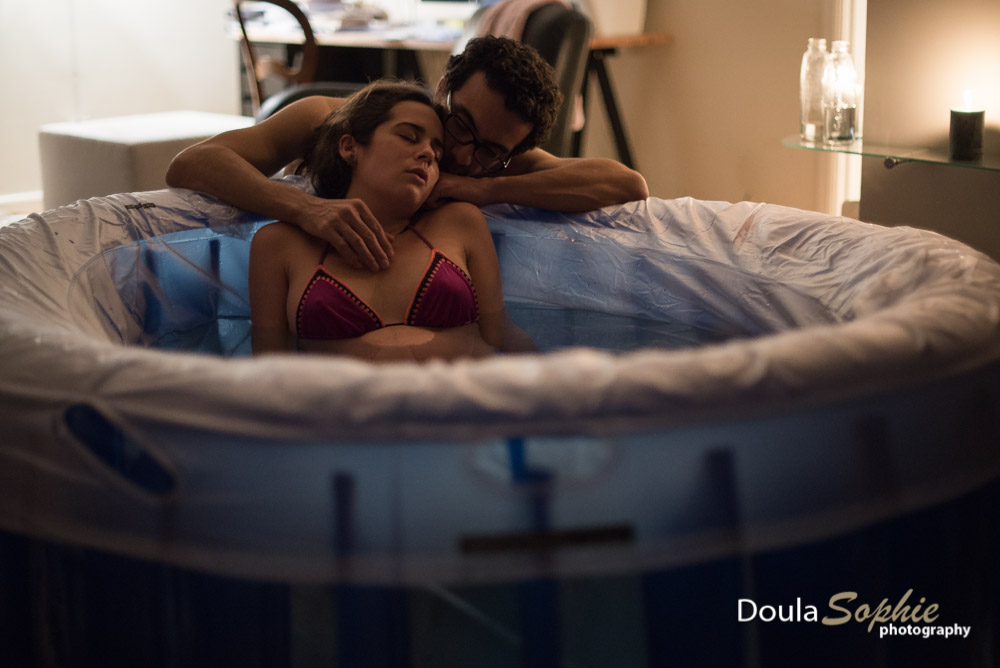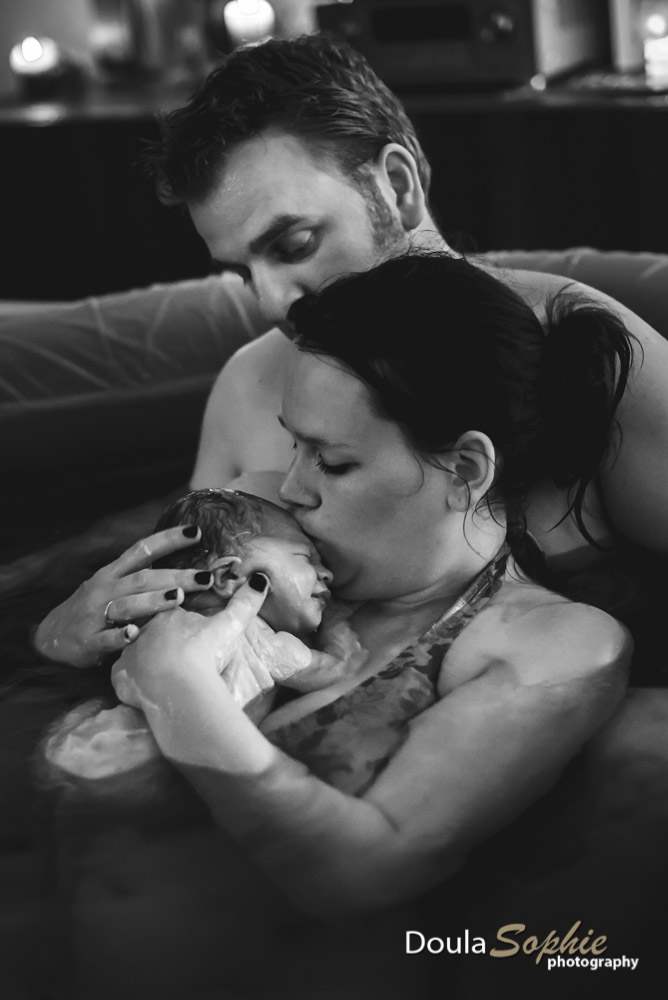The benefits of water for pain are huge!
You don’t have to birth the baby in water it is also great just for the pain relief!
Placing a pool of water in a birth room changes the atmosphere immediately. Voices get softer, the mother stays calmer and everyone becomes less stressed.
The effect of buoyancy, that immersion in water creates, allows easy movement of the mother. No one has to help the mother get into a new position. She moves as her body feels the need. Movement helps open the pelvis, allowing the baby to descend.
When a woman in labour relaxes in a warm deep bath she is free from gravity’s pull on her body and her body feels amazingly weightless. The sensitivity and irritation women can experience in their bodies when they are in labour is also reduced when in water as the sensory stimulation is dulled resulting in her body being less agitated by external ‘things.’
When a woman is relaxed in labour she is less likely to produce stress-related hormones and makes room for her body to produce the endorphins that are the bodies natural pain relief. A labouring woman who is able to relax physically, is able to relax mentally as well. Immersion in water also gives a sense of privacy and a personal space to feel safe in. A sense of safety is also very important for progress in the birth process.
Many women, midwives, and doctors acknowledge the analgesic effect of water. The effect is very clear when you see a labouring woman immerse herself in water or stand under the shower. Many women who have laboured in water say they would never be able to consider labouring without water again.
Research has verified many positive aspects of labouring and giving birth in water.
- Water facilitates mobility and enables the mother to assume any position which is comfortable for labour and birth.
- Can speed up labour
- Reduces blood pressure
- Gives mother more of a feeling of autonomy
- Provides significant pain relief
- Promotes relaxation
- Conserves mothers energy
- Reduces the need for drugs and interventions
- Gives mother a private protected space
- Softens the perineum and can reduce tearing
- A gentle beginning for baby
Dangerous?
Although water birth is becoming more widely accepted, for a long time many medical professionals thought it was dangerous to give birth in water. There were many unfounded myths surrounding giving birth in water. As a result of this it was not an option that was widely available. Still today, in The Netherlands, many midwives are afraid of supporting a water birth. Fears of not being able to measure blood loss or having to be more hands off during the birth of the baby are a few of the reasons given for not supporting water birth.
For an evidence based article on water birth and the research that has been done on it follow the link here: evidencebasedbirth.com
Maybe you really do not see yourself birthing your baby in the water …but let’s not throw the baby out with the bath water!! You don’t necessarily have to give birth to your baby in the water, although that can be amazing, what about just using it for pain relief?
Over the last few years the options for using water for labour and birth have grown, definitely in The Hague and Rotterdam. Midwives are being trained to support water birth and hospitals are seeing there is a demand for it.
The shower is often not considered and is also underestimated as a good form of pain relief. Women who use the shower though during labour can stay in there for hours sometimes. It really can help manage the pain. Almost all hospitals have showers in the en-suite bathrooms. A fantastic option for pain management.
Is water really an effective form of pain relief?
I cannot tell you how many labouring women I have heard groaning with relief at the effect the warm water has on the pain when they first enter the water. That feeling of heaviness in her pregnant body is lightened and there is an ease to which she can move and find comfortable positions in the water. The warmth helps the body relax and the contractions are often experienced as less painful.
Rianne said about her experience:
“I still remember the moment I got into the water. The warmth of the water made such a huge difference, I felt more relaxed, calm and focused. I was better able to get into my own “bubble.” Outside the water I needed help to cope with the contractions and as soon as I got inside the water I needed less help and didn’t feel ‘unsettled’ anymore. The water helped a lot to ease the pain. My score for the pain outside the water was 8/10 and inside the water it quickly became a 4/10.”
Rianne ended up not giving birth to her daughter in the water but had no regrets about having taken the trouble to rent a pool, take it to the birth centre and (have her partner) set it up. It was worth it all for the amazing relief it provided her.
So why not consider using water for pain management. Talk to your midwife about the options. One thing is for sure no woman who used this option ever said it was a waste of time and effort!
*Remember that if you have a medical indication, and are giving birth under the Gynecologist, your hospital of choice may have a pool but it is (in most cases) only available for women giving birth with an external (1st line) midwife practice.

How to mentally prepare for a birth in water
Firstly, you need to prepare your mind. Examine your own motivations, incentives and expectations for wanting a water birth. Ask yourself what made you decide to have a water birth and why – is it something you are doing for yourself or are you doing it because someone else expects you to? Remain flexible and let go of the expectation that you must birth your baby in any certain way. Examine how you might feel if your baby is not born in water. We cannot plan birth and there is always a good chance it will go differently than planned. So hold on to your wishes lightly, inform yourself well of the options and alternative scenarios. The more you know and open yourself up for other possibilities, the less surprises you will have along the way and that will result in less stress and a better birthing experience, water birth or not!
What temperature should the water be?
 The water temperature ought to be within 35C – 38C, depending on your preference. Adjust the temperature to your comfort. This can be done with a hose or by removing and then replacing some water with a bucket. If the water is too cold, you will use your energy trying to keep warm and become tense. If the water is too hot you’ll feel drowsy, overheated and may become dehydrated. Your blood pressure will drop which can make you feel faint and you’ll have a greater tendency to bleed after the birth. If you just want localized heat, for example on your back, wet hot wash cloths can be used. Cold wash cloths are great for cooling your face. It is normal for women during labour to one minute be too hot and the other too cold, your body is working very hard to birth your baby, so expect a little of that.
The water temperature ought to be within 35C – 38C, depending on your preference. Adjust the temperature to your comfort. This can be done with a hose or by removing and then replacing some water with a bucket. If the water is too cold, you will use your energy trying to keep warm and become tense. If the water is too hot you’ll feel drowsy, overheated and may become dehydrated. Your blood pressure will drop which can make you feel faint and you’ll have a greater tendency to bleed after the birth. If you just want localized heat, for example on your back, wet hot wash cloths can be used. Cold wash cloths are great for cooling your face. It is normal for women during labour to one minute be too hot and the other too cold, your body is working very hard to birth your baby, so expect a little of that.
When should I get into the water?
A woman should be encouraged to use the labor pool whenever she wants. However, if she chooses to get into the water in early labor, before her contractions are strong and close together, the water may relax her enough to slow or stop labour altogether. It’s best to wait until you have a strong desire to be in the water or your contractions are strongly established and you are in active labour. Some recommend waiting until you’re at least 5 cms dilated, that way you save the pain relieving effect for the time you need it most. If labour slows down when you are outside the water, try getting into the tub as this might stimulate labour. If your progress slows down whilst you are in the tub, get out, empty your bladder and move around to stimulate labour. Often it is the CHANGE of environment that gets labour moving again. Women’s bodies are all different. The first hour of relaxation in the pool is usually the best and can often help a woman dilate quicker.
What can I drink and eat?
 Drink to thirst. Ask your partner to remind you to drink to avoid dehydration, which can result in fatigue and a poorly functioning uterus. Eating and drinking during labour has been shown to reduce the total length of labour by as much as 90 minutes. Eat light, easily digested food.
Drink to thirst. Ask your partner to remind you to drink to avoid dehydration, which can result in fatigue and a poorly functioning uterus. Eating and drinking during labour has been shown to reduce the total length of labour by as much as 90 minutes. Eat light, easily digested food.
Birth positions for a water birth
Experiment with a variety of different positions while in the tub. Try kneeling, squatting, leaning, sitting or lying outstretched (body facing up or down.) Your body will typically move til it finds a position that feels more comfortable. Some women prefer their partner to be in the pool with them to hold onto and act as an anchor, others prefer to be in the bath alone.
When does the baby take its first breath?
The baby doesn’t breathe until after its face leaves the water and its skin comes into contact with the air or it is stimulated when out of the water.
Until then, the baby receives oxygen through its umbilical cord, as it has done during the 9 months of pregnancy. Discuss the actual birth moment with your midwife ahead of time. Many midwives feel comfortable with the time that it takes the mother to reach down and pick the baby up h erself, others (often less experienced in water birth) feel the need to have the baby come straight out of the water.
erself, others (often less experienced in water birth) feel the need to have the baby come straight out of the water.
Often a mother will have an automatic response and bring the baby straight out of the water to her chest. If she has thought about it before hand she may take the time to just pause for a moment while the baby is immersed under water and look at her little one before bringing it up out of the water. As long as no part of the baby has come out of the water this is fine and safe to do. Remember that the great benefits of water have already been achieved as soon as the infant is born into the warm water. Sometimes babies born in water are so calm at birth it can appear that they aren’t breathing. Gently rub their back or blow on their face and they will gasp. Being born from water into water is a gentle start for a baby and these water babies sometimes need a little more time to literally land on earth.
The placenta
 Some women like to stay in the pool after the birth to enjoy the moment and bond with the baby. Many women want to get out quite soon after and get into a nice warm bed. Birthing the placenta in the water is usually fine. Some midwives prefer the placenta to be born out of the water due to the difficulty to judge accurate blood loss. When it is time for the placenta to come, your midwife may ask you to get out of the pool. Discuss what you both feel comfortable with beforehand and what the scenarios may be that would change this stage of the process.
Some women like to stay in the pool after the birth to enjoy the moment and bond with the baby. Many women want to get out quite soon after and get into a nice warm bed. Birthing the placenta in the water is usually fine. Some midwives prefer the placenta to be born out of the water due to the difficulty to judge accurate blood loss. When it is time for the placenta to come, your midwife may ask you to get out of the pool. Discuss what you both feel comfortable with beforehand and what the scenarios may be that would change this stage of the process.
Tips for water birth in general
 Know that at any time the situation can change and you may need to let go of your dream water birth. Hold the dream lightly so you can let go of it at any moment yet at the same time prepare well so you know you have done all you can to achieve your goal of birthing your baby in water.
Know that at any time the situation can change and you may need to let go of your dream water birth. Hold the dream lightly so you can let go of it at any moment yet at the same time prepare well so you know you have done all you can to achieve your goal of birthing your baby in water.- Stick a sticker on the bottom of the pool. This can help to indicate how much blood loss there is. If you can still see the sticker post birth then it is usually fine. Also if you can still see what colour your legs are then your blood loss is safe.
- To prevent the baby’s breathing reflex from kicking in the baby needs to stay completely under water till its whole body is born. The water needs to be at least 65cm deep. The water should ideally come up to under your breasts if you are sitting.
- The water should be refreshed after 24 hours to prevent bacteria forming.
- It is wise to not stay longer than 2 hours in the bath without a break of 30 minutes or so. This gives optimal pain relief and the movement of getting out of the pool can help the baby move through the pelvis.
- Have an anti-slip mat to lay beside the pool for when you want to get out, old (or cheap)towels that can get dirty, a warm dressing gown and slippers.
- Think about using dark coloured towels as any stains do not show and it looks better in the photos (says the birth photographer in me
)
- Take two or so of your own large bath towels, the hospital towels are not so big (and that is an understatement!)
- It is a good idea to have a good torch/flash light with extra batteries for when the lighting is low and you want to see better whats going on in the water.
- Some pools have a place for the partner to sit. It is nice to have the option of having your partner in the water with you for support, especially during the pushing phase. Make sure he has swimming shorts with him, just in case.
- It is also nice to have candles, fairy lights or lighting that is dimmer for a more cozy and intimate atmosphere.
Extra tips for an enjoyable home water birth
- If you are planning a home water birth, or renting a pool to take to a birth centre, you should usually have the pool in the house by week 37. Some midwife practices and doula’s rent birth pools.
- If you have a wooden floor make sure your floor can handle the weight of the water filled pool. A large pool carries about 800 liters of water, which is 800 kilo in weight. With a good floor this should not be a problem but in some old houses it is worth checking this first.
- The room should be large enough to allow access from all sides. The midwife needs space to access the pool well.

- The temperature of the room you will be birthing in should be comfortable. It can be nice to have a blow fan close by in case you get too warm in the water.
- Have a practice run setting up the pool before hand. Time how long it takes to adequately fill the pool.
- The midwife may at any point need more light then it is handy to have a moveable spotlight.
- Have a low stool or children’s chair for the midwife to sit on next to the pool so she can sit comfortably too.
- If the pool will be set up in the living area or on a different floor than the bedroom, make a comfortable place in the same room as the pool for mother and baby to lie on. A good sofa or guest bed/mattress work fine. This way you can lie there and enjoy the baby after the birth instead of moving upstairs or to the bedroom. This can also be used if you need to birth the baby or the placenta outside of the water. Make sure it is protected well from bloodstains and covered well with an old sheet and plastic if needed. The box you get from the insurance should have special mats in for this.
- Have a few warm blankets or a duvet close by to keep mama and baby warm and lots of dark coloured towels





Leave a Reply